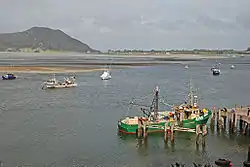Pukenui
Pukenui is a locality on the southwest side of Houhora Harbour on the Aupouri Peninsula of Northland, New Zealand. State Highway 1 runs through it.[3] The name means "large hill" in the Māori language.[4]
Pukenui | |
|---|---|
 Pukenui wharf | |
| Coordinates: 34.833°S 173.131°E | |
| Country | New Zealand |
| Region | Northland Region |
| District | Far North District |
| Ward | Te Hiku |
| Electorates | |
| Government | |
| • Territorial Authority | Far North District Council |
| • Regional council | Northland Regional Council |
| Area | |
| • Total | 20.69 km2 (7.99 sq mi) |
| Population (June 2023)[2] | |
| • Total | 810 |
| • Density | 39/km2 (100/sq mi) |
Demographics
Statistics New Zealand describes Pukenui as a rural settlement. It covers 20.69 km2 (7.99 sq mi)[1] and had an estimated population of 810 as of June 2023,[2] with a population density of 39 people per km2. Pukenui is part of the larger North Cape statistical area.[5]
| Year | Pop. | ±% p.a. |
|---|---|---|
| 2006 | 591 | — |
| 2013 | 615 | +0.57% |
| 2018 | 708 | +2.86% |
| Source: [6] | ||
Pukenui had a population of 708 at the 2018 New Zealand census, an increase of 93 people (15.1%) since the 2013 census, and an increase of 117 people (19.8%) since the 2006 census. There were 294 households, comprising 351 males and 354 females, giving a sex ratio of 0.99 males per female, with 114 people (16.1%) aged under 15 years, 75 (10.6%) aged 15 to 29, 321 (45.3%) aged 30 to 64, and 192 (27.1%) aged 65 or older.
Ethnicities were 78.0% European/Pākehā, 37.7% Māori, 3.0% Pacific peoples, 1.3% Asian, and 2.5% other ethnicities. People may identify with more than one ethnicity.
Of those people who chose to answer the census's question about religious affiliation, 47.9% had no religion, 36.4% were Christian, 4.2% had Māori religious beliefs, 0.4% were Muslim, 0.4% were Buddhist and 1.3% had other religions.
Of those at least 15 years old, 51 (8.6%) people had a bachelor or higher degree, and 174 (29.3%) people had no formal qualifications. 72 people (12.1%) earned over $70,000 compared to 17.2% nationally. The employment status of those at least 15 was that 234 (39.4%) people were employed full-time, 102 (17.2%) were part-time, and 24 (4.0%) were unemployed.[6]
Education
Pukenui School is a coeducational full primary (years 1-8) school[7] with a roll of 93 students as of April 2023.[8] The school first opened in 1896.[9]
References
- "ArcGIS Web Application". statsnz.maps.arcgis.com. Retrieved 19 March 2022.
- "Subnational population estimates (RC, SA2), by age and sex, at 30 June 1996-2023 (2023 boundaries)". Statistics New Zealand. Retrieved 25 October 2023. (regional councils); "Subnational population estimates (TA, SA2), by age and sex, at 30 June 1996-2023 (2023 boundaries)". Statistics New Zealand. Retrieved 25 October 2023. (territorial authorities); "Subnational population estimates (urban rural), by age and sex, at 30 June 1996-2023 (2023 boundaries)". Statistics New Zealand. Retrieved 25 October 2023. (urban areas)
- Harriss, Gavin (November 2021). Pukenui, Northland (Map). NZ Topo Map.
- Discover New Zealand:A Wises Guide (9th ed.). 1994. p. 58.
- 2018 Census place summary: North Cape
- "Statistical area 1 dataset for 2018 Census". Statistics New Zealand. March 2020. 7000007–7000009 and 7000011.
- Education Counts: Pukenui School
- "New Zealand Schools Directory". New Zealand Ministry of Education. Retrieved 12 December 2022.
- "Pukenui School centennial, 1896-1996 : Houhora-Waihopo (record)". National Library of New Zealand. 1996.